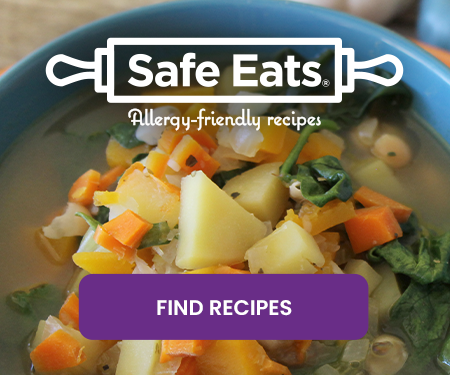Living with Food Allergies

Soy Allergy
A soy allergy is an immune system reaction to soy protein. Soy allergy can be severe and life-threatening if not treated promptly. If you have a child with a soy allergy, you must completely remove soy and soy-containing foods from their diet. It is possible to lead a healthy life without soy.
You can successfully manage soy allergy with good medical care, knowledge, support, and evidence-based resources. While there is no cure for soy allergy, this guide will help you manage it with confidence.
Closed
What are the symptoms of soy allergy?
There are two types of soy allergy:
- IgE-mediated – Your immune system makes antibodies called immunoglobulin E (IgE) antibodies. These IgE antibodies react with a certain food proteins, such as soy, and cause symptoms. This has the potential to cause a severe allergic reaction called anaphylaxis [anna-fih-LACK-sis].
- Non-IgE-mediated − Other parts of the body’s immune system react to soy in this type of reaction. This reaction causes symptoms too. But it does not involve an IgE antibody. Most of these symptoms affect your digestive tract such as diarrhea, constipation, weight loss, and bloating.
You can have both IgE-mediated and non-IgE-mediated food allergies. Symptoms in both types of these immune responses may overlap.
When you have an IgE-mediated soy allergy, you need to be aware of the symptoms of anaphylaxis. Symptoms of anaphylaxis may include hives, vomiting, or trouble breathing. The first-line and main anaphylaxis is injectable epinephrine.
Signs and symptoms of anaphylaxis include in children, teens, and adults include:
- Skin rash, itching, hives
- Swelling of the lips, tongue, or throat
- Shortness of breath, trouble breathing, wheezing
- Stomach pain, vomiting, diarrhea
- Feeling like something awful is about to happen
Common signs and symptoms of anaphylaxis in infants and toddlers include:2
- Skin rash, itching, hives
- Swelling of the lips, tongue, or throat
- Stomach pain, vomiting, diarrhea, spitting up
- Hiccups
- Arching back, bringing knees to the chest
- Coughing, wheezing
- Rubbing eyes, itchy or red eyes
Most symptoms of non-IgE mediated food allergies involve the digestive tract. Types of non-IgE mediated food allergies include:
- Eosinophilic [EE-oh-sin-oh-FILL-ick] esophagitis (EoE) – an allergic swallowing disorder caused by an inflamed esophagus (part of the throat)
- Food protein-induced enterocolitis syndrome (FPIES) [eff-PIES] – inflammation in the small intestine and colon (large intestine)
- Allergic proctocolitis [prahk-toe-koh-LIE-tis] – inflammation in the lower intestine caused by an allergy to cow’s milk or soy proteins found in formula or breast milk
Signs and symptoms of a non-IgE mediated soy allergy may include:
- Blood in stools, especially in infants
- Loose stools, diarrhea, constipation
- Upset stomach, stomach cramps, bloating
- Failure to thrive (slow to grow or gain weight), weight loss
The symptoms of non-IgE mediated food allergies usually go away when the food allergen (like milk or soy) is removed from the affected infant’s or child’s diet.
How do doctors diagnose soy allergy?
A doctor will do a physical exam and ask questions about medical history. They will ask about what happens when your child eats soy. They will want to know how soon symptoms appeared after eating and if and how you treated it and if the treatment was effective.
If they suspect an IgE-mediated soy allergy, they may order allergy testing to help confirm the diagnosis. A skin prick test or a blood test known as a specific IgE test may be used by your doctor to help diagnose this food allergy. Allergy testing is generally not helpful or suggested for non-IgE-mediated reactions.
The allergist may do another test called an oral food challenge to diagnose a soy allergy or confirm if you child has outgrown the allergy. There are other conditions that may be triggered by soy (such as non-IgE mediated soy allergy), so you may also receive a referral to a gastroenterologist (or “GI doctor”).
How can I prevent soy allergy reactions?
Soy can be found in almost any type of food. Foods that contain soy include ice creams, baked goods, plant-based or vegan meat alternatives, milk alternatives, and so much more.
The only way to avoid an allergic reaction is to completely remove soy completely from your child’s diet.
But you can successfully manage soy allergy with education and an allergy management plan. This can be done by:
- Working with your doctor
- Reading labels
- Being aware of cross-contact (when foods come into contact with each other and may transfer an allergen into a food that shouldn’t have it)
- Clearly communicating with school staff, people who prepare your food, and babysitters and other caregivers
How do I read a label for soy?
Always read the entire ingredient label to look for the names of soy. The federal Food Allergen Labeling and Consumer Protection Act (FALCPA) requires that all packaged foods regulated by the FDA must list “soy” clearly on the ingredient label if it contains soy*. Soy ingredients may be within the list of the ingredients. Or it could be listed in a “contains: soy” statement beneath the list of ingredients.
For example:
- Yuba (soy)
- Contains: Soy
Sometimes soy may appear in bold print in the ingredient list too.
FALCPA does not require highly refined soy or soybean oil to be labeled as a major allergen on an ingredient statement. This form of soy oil does not contain significant amounts of protein to cause an allergic reaction. But you should avoid cold-pressed, expelled, or extruded soy oils (otherwise known as gourmet soy oils) since these may contain soy protein.
Advisory statements – called precautionary allergen labelling (PAL) – such as “may contain soy” or “made in a facility with soy” are not required by any federal labeling law. Discuss with your doctor if you may eat products with these labels or if you should avoid them. If you have questions about advisory labels, talk with your doctor.
If a food item does not have a label, you can’t read it, or you have any doubts, don’t eat it. Always read the entire label every time. Food companies may change their recipes.
The FALCPA does not apply to all foods and everything that may contain soy though. This means soy could be “hidden” in products or listed under other names. Or you may not be able to find out the exact ingredients. These foods and products do not have to have soy clearly listed or labeled and may contain soy:
- Arts and crafts supplies
- Prescription and over-the-counter drugs
- Cosmetics and personal care items (such as, makeup, lotions, and soaps)
- Alcohol
- Toys
- Pet food
- Food served in restaurants, cafeterias, or other food service providers
There are many different names for soy. When shopping and cooking, have a list of the different names of soy on hand to check food packages or menus for soy ingredients. We have compiled a list of the different names of soy below. You can also download and print Kids with Food Allergies’ (KFA) Guide to Managing Soy Allergy and Chef Cards.
Most states in the U.S. do not have regulations regarding food allergies and restaurants. Ingredients in restaurant foods may vary. Cross-contact is also more likely. Many restaurants are becoming more food allergy aware though. Look for places that have food allergy policies and allergy menus. Give the staff a chef card that alerts them to your allergy and lists soy ingredients for them to watch for.
Soy ingredient list
Bean curd
Edamame (soybeans in pods)
Hydrolyzed soy protein
Kinako (roasted soybean flour)
Koya dofu (freeze dried tofu)
Miso
Natto
Okara (soy pulp)
Shoyu
Soy albumin
Soy cheese
Soy concentrate
Soy fiber
Soy formula
Soy grits
Soy ice cream
Soy milk
Soy miso
Soy nuts
Soy nut butter
Soy protein, soy protein concentrate, soy protein isolate
Soy sauce
Soy sprouts
Soy yogurt
Soya
Soya flour
Soybeans
Soybean granules
Soybean curd
Soybean flour
Soy lecithin**
Soybean paste
Supro
Tamari
Tempeh
Teriyaki sauce
Textured soy flour (TSF)
Textured soy protein (TSP)
Textured vegetable protein (TVP)
Tofu
Yaki-dofu (grilled tofu)
Yuba (bean curd)
SOY IS SOMETIMES FOUND IN
Artificial flavoring
Asian foods (such as Japanese, Chinese, Thai, Vietnamese, etc.)
Baked goods
Canned broths and soup
Canned meat and fish
Grains prepared with soy (such as cereals, breads, chips, crackers, pasta, rice, tortillas, rice)
High protein energy foods
Hydrolyzed plant protein
Hydrolyzed vegetable protein (HVP)
Infant formulas
Lecithin**
Low-fat peanut butter
Natural flavoring
Processed meats, sausages, and sauces
Vegan, vegetarian, and plant-based foods
Vegetable broth
Vegetable gum
Vegetable starch
However, if the food is regulated by the FDA, the word “soy” must appear on the label.
SHOULD BE SAFE
These soy derivatives should be safe for most people with soy allergy:
*Soy oil that is highly refined and distilled (but avoid cold pressed, expeller pressed, or extruded soybean oil)
*Vegetable oil derived from soy
TAKE NOTE
**Lecithin:
Products that are covered by the FDA labeling laws and contain soy lecithin as an ingredient must be labeled to state that they contain soy.
 Download or Order Print Copies: “A Guide to Managing Soy Allergy” (Includes Chef Cards and More) |
 Download or Order Print Copies: Soy Allergy Chef Cards |
Are soy oil and soy lecithin safe for people with soy allergy?
Highly refined soy or soybean oil will not be labeled as a major allergen on an ingredient statement. There are clinical studies showing that people with a food allergy can eat highly refined oils. This is because highly refined oils contain extremely small levels of allergenic protein.
However, people with soy allergy need to avoid any expeller pressed, extruded, or cold-pressed soy oil. These types of oil do contain soy protein and must be listed on the label as an allergen.
Soy lecithin contains a small amount of soy protein. For this reason, products containing soy lecithin will label those foods for the presence of soy. The amount of soy protein in soy lecithin is low enough that it usually does not result in an allergic reaction in most people allergic to soy.1
If you have questions about whether or not you should avoid soy lecithin and soy oil, talk with your allergist.
Does my child need to avoid foods related to soy?
Cross-reactivity occurs when the proteins in one food are similar to the proteins in another. When that happens, the body’s immune system sees them as the same.
Soy is a legume. The legume family includes different beans, including peanuts, peas, and lentils. A common question that comes up for people with an allergy to one legume is whether they can eat other legumes. It turns out that 95% of people who have an allergy to one legume can tolerate and eat other legumes just fine.
How can I make sure my child gets enough nutrition on a soy-free diet?
Soybeans provide one of the highest quality proteins in a child’s diet. They also contain thiamin, riboflavin, iron, phosphorus, magnesium, calcium, zinc, and vitamin B6. Unless your child consumes large portions of soy, the small amounts of soy in processed foods do not supply a significant amount of these nutrients. A soy-restricted diet will not pose any nutritional risk if your child is eating a variety of fruits, vegetables, enriched and fortified grains, and tolerated sources of protein.
| NUTRIENTS LOST WHEN AVOIDING SOY |
SUGGESTED ALTERNATE SOURCES (if not allergic) |
| Protein, thiamin, riboflavin, iron, calcium, zinc, vitamin B6 | Increase other protein foods such as meat, fish, poultry, legumes, eggs, dairy (if safe for your child); fruit, vegetables, leafy greens and enriched grains |
What formula options are available for my infant or toddler?
Some infants and toddlers develop food intolerances or allergies. Soy is a common food babies can react to. If they are breastfed, they may or may not react to food proteins the mother eats that passes through her breast milk. Consult a doctor (and registered dietitian) before eliminating soy from the mother’s diet.
Formula-fed infants with soy allergy may not tolerate the food proteins (such as milk or soy) in infant and toddler formulas. There are several formula options available for young children with food allergies. Work with your child’s doctor to find the best formula for your child.
How do I substitute soy in recipes?
Soy Substitutions in Recipes
Soy is a common ingredient in foods in the US. Rice-based and coconut-based alternatives are available if you need to avoid cow’s milk and soy. Whole soy beans (edamame) can be replaced with other beans (fava, garbanzo).
Learn more about using soy substitutes..
Soy-Free Recipes
Nearly 1,500 soy-free recipes are available in KFA’s Safe Eats™ Allergy-Friendly Recipe Collection. Search for soy-free recipes.
Will my child outgrow their soy allergy?
Are there any treatments for soy allergy?
Currently, there are no FDA-approved treatments for soy allergy (as of December 2022). The best way to prevent soy allergy reactions is to avoid wheat completely. But some research is being done on soy allergy treatments, such as oral immunotherapy (OIT).
Many doctors have been offering OIT treatment using foods in various forms, such as a liquid, flour, or the actual food itself. These methods are not approved by the FDA. Talk with your child’s doctor about the most appropriate OIT option for your child. The FDA is looking at other food allergy treatments to fast track through the approval process to address this unmet need in the food allergy community.
There are many known side effects or possible adverse reactions to OIT. Talk with your allergist to see if this treatment might be right for your child and family.
Medical Review: December 2022 by John James, MD
References
1. Savage JH, Kaeding AJ, Matsui EC, Wood RA. The natural history of soy allergy. J Allergy Clin Immunol, 2010;125:683-86.
2. Pistiner, M., Mendez-Reyes, J. E., Eftekhari, S., Carver, M., Lieberman, J., Wang, J., & Camargo, C. A. (2021). Caregiver-reported presentation of severe food-induced allergic reactions in infants and toddlers. The Journal of Allergy and Clinical Immunology: In Practice, 9(1). https://doi.org/10.1016/j.jaip.2020.11.005
3. Food Allergy Research and Resource Program. Soybeans and Soy Lecithin. http://farrp.unl.edu/resources/gi-fas/opinion-and-summaries/soy-lecithin
Ask the Allergist
Have a question on managing food allergies, asthma, other allergic conditions? Our allergist can help.














